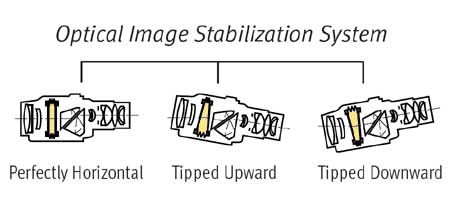
Large aperture high power binoculars are a very useful tool for astronomy. They
complement the close up view of a telescope by letting you see the big picture -
of open star clusters, galaxies like Andromeda, comets, and more. But it's hard
to hold a conventional big binocular steady enough to examine the sky at length.
Your arms soon get tired and you develop unavoidable hand tremors that blur the
images and fuzz the details. No more. Canon active image-stabilized binoculars make
those blurred high power images obsolete. Their rock-steady and unblurred images
mean there is not only more detail to see, and see clearly, but there is also minimal
eye fatigue to tire you out and bring on headaches.
The Canon IS (Image Stabilized) binoculars have two Vari-Angle Prisms located between
the objective lenses and the image-erecting prisms. If the binocular tilts quickly
(from even minor hand tremors, for example), horizontal and vertical sensors detect
the motion. A microprocessor adjusts the Vari-Angle Prisms in the right and left
sides of the binocular independently to compensate for a tilt up to +/- 0.7° - far
more motion than any fatigue-induced tremor.
Each prism expands or contracts in a bellows motion to redirect the light path and
compensate for the tilt. This instantly and precisely adjusts the direction of the
visual path through the binoculars to maintain a perfectly steady and centered image,
even while the binocular moves. The result is a clear, high power, hand-held image
at the push of a button.
The diagram below shows the action of the Vari-Angle Prisms and the results you
can expect. You can see the changing "bellows" action of the Vari-Angle Prisms (yellow
in the diagram) as the tilt of the binocular changes.

|

|








